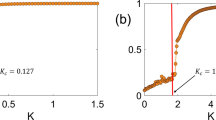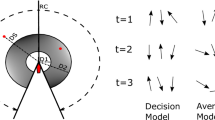Abstract
This article investigates the chaotic dynamical characteristics of a discrete-time social foraging swarm model in which the individuals move in a d-dimensional space according to an attractant/repellent or a nutrient profile. The collective behavior of the swarm model results from the balance between inter-individual interactions and the simultaneous interactions of the swarm members with their environment. Analysis undertaken in the paper indicates that chaos can be introduced into the system by tuning the parameters of the mutual attraction-repulsion function and the attractant–repellent profiles of the swarm dynamics [as given in Eq. (1)]. Ranges of different parameters to ensure sufficient condition for chaotic characteristics have been determined. Apart from chaos, stable and limit cyclic behaviors are also demonstrated for various parameter ranges. Effect of different attractant/repellent gradient profiles on the mean swarm trajectory in the presence of chaos has also been studied. Presence of chaos is determined by means of the Lyapunov exponent. Results obtained from the theoretical analysis are validated through comprehensive simulations.







Similar content being viewed by others
References
Andrews, B.B.W., Passino, K.M., Waite, T.A.: Social foraging theory for robust multiagent system design. IEEE Trans. Autom. Sci. Eng. 4(1), 79–86 (2007)
Buhl, J., Sumpter, D.J.T., Couzin, I.D., Hale, J.J., Despland, E., Miller, E.R., Simpson, S.J.: From disorder to order in marching locusts. Science 312(5778), 1402–1406 (2006)
Egerstedt, M., Hu, X.: Formation constrained multi-agent control. IEEE Trans. Robot. Autom. 17, 947–951 (2001)
Fax, J.A., Murray, R.M.: Information flow and cooperative control of vehicle formations. IEEE Trans. Autom. Control 49(9), 1465–1476 (2004)
Gil, A., Passino, K.M., Ganapathy, S., Sparks, A.: Cooperative task scheduling for networked uninhabited air vehicles. IEEE Trans. Aerosp. Electron. Syst. 44(2), 561–581 (2008)
Gil, A., Passino, K.M., Cruz, J.B.: Stable cooperative surveillance with information flow constraints. IEEE Trans. Control Syst. Technol. 16(5), 856–868 (2008)
Dimarogonas, D.V., Kyriakopoulos, K.J.: On the rendezvous problem for multiple nonholonomic agents. IEEE Trans. Autom. Control 52(5), 916–922 (2007)
Cortes, J., Martinez, S., Karatas, T., Bullo, F.: Coverage control for mobile sensing networks. IEEE Trans. Robot. Autom. 20(2), 243–255 (2004)
Gershenson, C.: Computing networks: a general framework to contrast neural and swarm cognitions. Paladyn J. Behav. Robot. 1(2), 147–153 (2010)
Mogilner, A., Edelstein-Keshet, L.: A nonlocal model for a swarm. J. Math. Biol. 38, 534–570 (1999)
Durrett, R., Levin, S.: The importance of being discrete (and spatial). Theor. Pop. Biol. 46, 363–394 (1994)
Dorigo, M., Stützle, T.: Ant Colony Optimization. MIT Press, Cambridge (2004)
Kennedy, J., Eberhart, R.C., Shi, Y.: Swarm Intelligence. Morgan Kaufmann, San Mateo (2001)
Passino, K.M.: Biomimicry of bacterial foraging for distributed optimization and control. IEEE Control Syst. Mag. 22(3), 52–67 (2002)
Jin, K., Liang, P., Beni, G.: Stability of synchronized distributed control of discrete swarm structures. In: Proceedings of IEEE International Conference on Robotics and Automation, pp. 1033–1038. San Diego, CA (May 1994)
Gazi, V., Passino, K.M.: Stability analysis of swarms. IEEE Trans. Autom. Control 48(4), 692–697 (2003)
Gazi, V., Passino, K.M.: A class of attraction/repulsion functions for stable swarm aggregations. In: Proceedings of Conference on Decision and Control, pp. 2842–2847. Las Vegas, NV (2002, December)
Gazi, V., Passino, K.M.: Stability analysis of social foraging swarms. IEEE Trans. Syst. Man Cybern. B 34(1), 539–557 (2004)
Leonard, N.E., Fiorelli, E.: Virtual leaders, artificial potentials and coordinated control of groups. In: Proceedings of Conference on Decision and Control, pp. 2968–2847. Orlando, FL (2001)
Liu, Y., Passino, K.M., Polycarpou, M.M.: Stability analysis of one-dimensional asynchronous swarms. IEEE Trans. Autom. Control 48(10), 1848–1854 (2003)
Liu, Y., Passino, K.M., Polycarpou, M.M.: Stability analysis of m-dimensional asynchronous swarms with a fixed communication topology. IEEE Trans. Autom. Control 48(1), 76–95 (2003)
Li, W.: Stability analysis of swarms with a general topology. IEEE Trans. Syst. Man Cybern. B 38(4), 1084–1097 (2008)
Ott, E.: Chaos in Dynamical Systems. Cambridge University Press, NewYork (2002)
Kautz, R.: Chaos: The Science of Predictable Random Motion. Oxford University Press, Oxford (2011)
Chen, P.: Empirical, theoretical evidence of economic chaos. Syst. Dyn. Rev. 4, 81 (1988)
Frank, G.W., Lookman, T., Nerenberg, M.A.H., Essex, C., Lemieux, J., Blume, W.: Chaotic time series analysis of epileptic seizures. Phys. D 46, 427 (1990)
Goldberger, A.L., West, B.J., Rigney, D.R.: Chaos and fractals in human physiology. Sci. Am. 262, 42–49 (1990)
Freeman, W.J.: Brain dynamics: brain chaos and intentionality. In: Gordon, E. (ed.) Integrative Neuroscience-Bringing Together Biological, pp. 163–171. Psychological and Clinical Models of the Human Brain, Harwood Academic Publishers, Sydney (2000)
Sarbadhikari, S.N., Chakrabarty, K.: Chaos in the brain: a short review alluding to epilepsy, depression, exercise and lateralization. Med. Eng. Phys. 23, 445–455 (2001)
Aihara, K., Takabe, T., Toyoda, M.: Chaotic neural networks. Phys. Lett. A 144, 333–340 (1990)
Nozawa, H.: A neural-network model as a globally coupled map and applications based on chaos. Chaos 2(3), 377–386 (1992)
Chen, L.N., Aihara, K.: Chaotic simulated annealing by a neural network model with transient chaos. Neural Netw. 8(6), 915–930 (1995)
Wang, L.P., Smith, K.: On chaotic simulated annealing. IEEE Trans. Neural Netw. 9(4), 716–718 (1998)
Wang, L.P., Tian, F.Y.: Noisy chaotic neural networks for solving combinatorial optimization problems. In: Proceedings of International Joint Conference on Neural Networks (IJCNN’00), vol. 4, pp. 37–40 (July 2000)
Wang, L.P., Li, S., Tian, F., Fu, X.: A noisy chaotic neural network for solving combinatorial optimization problems: stochastic chaotic simulated annealing. IEEE Trans. Syst. Man Cybern. Part B Cybern. 34(5), 2119–2125 (2004)
Cao, Y., Liu, S., Liu, X.: Optimization of SF/sub 6/circuit breaker based on chaotic neural network. IEEE Trans. Magn. 42, 1151–1154 (2006)
Wang, L.P., Liu, W., Shi, H.: Delay constrained multicast routing using the noisy chaotic neural networks. IEEE Trans. Comput. 58(1), 82–89 (2009)
Zhong, W., Cheng, S.-X.: Multiuser detection using time-varying scaling-parameter transiently chaotic neural networks. Electron. Lett. 35, 987–989 (1999)
Wang, L.P., Pichler, E.E., Ross, J.: Oscillations and chaos in neural networks: an exactly solvable model. Proc. Natl. Acad. Sci. (USA) 87, 9467–9471 (1990)
Wang, L.P.: Oscillatory and chaotic dynamics in neural networks under varying operating conditions. IEEE Trans. Neural Netw. 7(6), 1382–1388 (1996)
Wang, L.P.: Suppressing chaos with hysteresis in a higher order neural network. IEEE Trans. Circuit Syst. II Anal. Digit. Signal Process. 43(12), 845–846 (1996)
Wang, L.P., Liu, W., Shi, H., Zurada, J.M.: Cellular neural networks with transient chaos. IEEE Trans. Circuits Syst. II Express Briefs 54(5), 440–444 (2007)
Das, S., Halder, U., Maity, D.: Chaotic dynamics in social foraging swarms—an analysis. IEEE Trans. Syst. Man Cybern. B 42(4), 1288–1293 (2012)
Cencini, M., Cecconi, F., Vulpiani, A.: Chaos from Simple Models to Complex Systems. World Scientific, Singapore (2010)
Wolf, A., Swift, J.B., Swinney, H.L., Vastano, J.A.: Determining Lyapunov exponents from a time series. Phys. D 16, 285–317 (1985)
Author information
Authors and Affiliations
Corresponding author
Appendix
Appendix
1.1 Boundary values of \(Z\big (\xi _p^{ij} \big )\)
We have defined,
\(Z\big (\xi _p^{ij} \big )\!=\!\left( {1\!-\!\frac{2}{c}\left( {x_p^i -x_p^j } \right) ^{2}} \right) \cdot \exp \left( {-\;\frac{\left\| {{\varvec{x}}^{i}-{\varvec{x}}^{j}} \right\| ^{2}}{c}} \right) .\) For each and every dimension we have a similar dynamical equation like (7) and we there is a function like \(Z\big (\xi _p^{ij} \big )\). We have to find a vector \({\varvec{\xi }}^{ij} ={\varvec{x}}^{i}-{\varvec{x}}^{j}\), which gives the extreme value of \(Z\big (\xi _p^{ij} \big )\). Indeed this is a multi-objective problem where we have d objective functions \(\big (Z\big (\xi _1^{ij} \big ), \,Z\big (\xi _2^{ij} \big ), {\ldots },Z\big (\xi _d^{ij} \big )\big )\) for d dimensions. As for our analysis every dimension is alike so we are only interested for those solutions of the multi-objective problem which gives equal extreme value for each dimensional component. Now if the extreme values are equal for each dimension then we can write,
The above condition will be satisfied if and only if
If condition (21) is satisfied then we can write,
From (22) one can easily find out the maximum and minimum value of \(Z\big (\xi _p^{ij} \big )\). And the maximum and minimum values are 1 and \(-2\cdot \exp (-(1+d/2))/d\) and the corresponding values of \(\xi _p^{ij} \) are 0 and \(\pm \sqrt{(d+2)c/2}\).
1.2 Chaotic condition or Case II(A)
Case (i) For \(k>0\).
If either \(1-A_\sigma -a(M-1)(1-Z_m k)>1\) or \(1-A_\sigma -a(M-1)(1-k)<-1\); then the swarm will be chaotic as per Eq. (9a). So we get,
Combining these two we get,
Case (ii) For \(k<0\).
To have chaos either \(1-A_\sigma -a(M-1)(1-k)>1\) or \(1-A_\sigma -a(M-1)(1-Z_m k)<-1\) .
Combining these two we get,
Thus the condition of chaos can be written by the following way,
Here we can easily notice that how the parameters of the gradient profile affect the range of k to ensure chaos. Case II(A) is a quadratic profile whose optima is at \({\varvec{c}}_\sigma \). Both \({\varvec{c}}_\sigma \) and \(b_\sigma \) do not have any effect on the chaotic conditions. But their effect will be clear when we will be considering the mean swarm trajectory.
1.3 Chaotic condition or Case II(B)
Case (i) For \(k>0\).
To ensure chaos, either \(1-\sum _{l=1}^N {A_\sigma ^l } -a(M-1)(1-Z_m k)>1\) or \(1-\sum _{l=1}^N {A_\sigma ^l } -a(M-1)(1-k)<-1\).
Combining these two we get,
Case (ii) For \(k<0\).
Similarly for this case the chaos will be ensured if either \(1-\sum _{l=1}^N {A_\sigma ^l } -a(M-1)(1-k)>1\) or \(1-\sum _{l=1}^N {A_\sigma ^l } -a(M-1)(1-Z_m k)<-1\).
Combining these two we get,
Thus the condition of chaos can be written by the following way,
In this case the gradient profile is a sum of N quadratic profiles; the effect of the parameters of the gradient profile is clearly observable from above expression. The effect of other parameters will be clear in Sect. 3.
1.4 Chaotic condition or Case III(A)
Case (a) When \(A_\sigma \) is positive:
Case (i) For \(k>0\).
From (11a) we can ensure chaos if either
Combining these two we get,
Case (ii) For \(k<0\).
Similarly from (11b) we can write, either \(1-\frac{A_\sigma }{l_\sigma }-a(M-1)(1-k)>1\) or \(1+\frac{2A_\sigma }{d\cdot l_\sigma }\cdot \exp (-(1+d/2))-a(M-1)(1-Z_m k)<-1\).
Combining these two we get,
Thus the sufficient condition or chaos for positive \(A_\sigma \) is,
Case (b) When \(A_\sigma \) is negative:
Case (i) For \(k>0\).
For this case chaos will be found if either, \(1+\frac{2A_\sigma }{d\cdot l_\sigma }\cdot \exp (-(1+d/2))-a(M-1)(1-Z_m k)>1\) or \(1-\frac{A_\sigma }{l_\sigma }-a(M-1)(1-k)<-1\).
Combining these two we get,
Case (ii) For \(k<0.\)
The swarm will exhibit a chaotic phenomenon for either,
Combining these two we get,
Thus the sufficient condition or chaos for negative \(A_\sigma \) is,
The above expressions clearly show that how chaotic phenomenon can be controlled by the parameters of the Gaussian profile.
1.5 Chaotic condition or Case III(B)
Case (a) When all the \(A_\sigma ^l\) are positive:
Case (i) For \(k>0\).
To have deterministic chaos in the swarm, either \(1-\sum _{l=1}^N {\frac{A_\sigma ^l }{l_\sigma ^l }} -a(M-1)(1-Z_m k)>1\) or \(1+2\cdot \frac{\exp (-(1+d/2))}{d}\cdot \sum _{l=1}^N {\frac{A_\sigma ^l }{l_\sigma ^l }} -a(M-1)(1-k)<-1\).
Combining these two we get,
Case (ii) For \(k<0.\)
Similarly for here, to ensure chaos either \(1-\sum _{l=1}^N {\frac{A_\sigma ^l }{l_\sigma ^l }} -a(M-1)(1-k)>1\) or \(1+2\cdot \frac{\exp (-(1+d/2))}{d}\cdot \sum _{l=1}^N {\frac{A_\sigma ^l }{l_\sigma ^l }} -a(M-1)(1-Z_m k)<-1\).
Combining these two we get,
Thus the sufficient condition or chaos for positive \(A_\sigma \) is,
Case (b) When all the \(A_\sigma ^l \) are negative:
Case (i) For \(k>0\).
Either \(1+2\cdot \frac{\exp (-(1+d/2))}{d}\cdot \sum _{l=1}^N {\frac{A_\sigma ^l }{l_\sigma ^l }} -a(M-1)(1-Z_m k)>1\) or \(1-\sum _{l=1}^N {\frac{A_\sigma ^l }{l_\sigma ^l }} -a(M-1)(1-k)<-1\).
Combining these two we get,
Case (ii) For \(k<0.\)
Either \(1+2\cdot \frac{\exp (-(1+d/2))}{d}\cdot \sum _{l=1}^N {\frac{A_\sigma ^l }{l_\sigma ^l }} -a(M-1)(1-k)>1\) or \(1-\sum _{l=1}^N {\frac{A_\sigma ^l }{l_\sigma ^l }} -a(M-1)(1-Z_m k)<-1\).
Combining these two we get,
Thus the sufficient condition or chaos for negative \(A_\sigma \) is,
Rights and permissions
About this article
Cite this article
Das, S. Chaotic patterns in the discrete-time dynamics of social foraging swarms with attractant–repellent profiles: an analysis. Nonlinear Dyn 82, 1399–1417 (2015). https://doi.org/10.1007/s11071-015-2247-2
Received:
Accepted:
Published:
Issue Date:
DOI: https://doi.org/10.1007/s11071-015-2247-2




